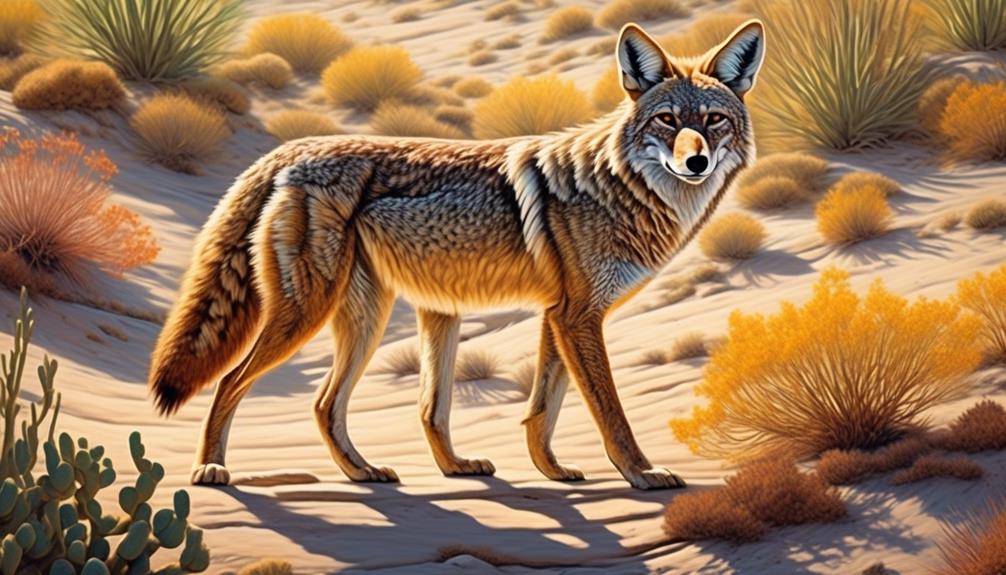So, you think you know everything there is to know about coyotes? Well, think again. Prepare to be amazed as we uncover the secrets of the different coyote species that roam the vast lands of North America.
From the cunning Western Coyotes to the enigmatic Central American Coyotes, and the majestic Eastern Coyotes, each species has its own unique characteristics that will leave you wanting to know more.
But that’s not all – we’ll also explore hazing techniques to keep these crafty canids at bay and unravel the mysteries behind their varying sizes and behaviors.
Get ready to discover a whole new world of coyotes that will leave you craving for more.
Western Coyotes: Distribution and Diet
Western coyotes, found in the western side of North America, have a wide distribution across various habitats in the western United States, western Canada, and parts of Mexico, and play a vital ecological role in regulating prey populations.
They’ve a diverse diet, including small mammals, birds, reptiles, fruits, and carrion. Western coyotes are opportunistic hunters and scavengers, adapting their diet based on the availability of food sources in their environment. They’re skilled predators, using their keen senses of smell, hearing, and sight to locate and capture their prey.
Western coyotes are known for their ability to thrive in a variety of habitats, including deserts, grasslands, forests, and urban areas. Their adaptability and flexibility in diet allow them to successfully exploit different ecosystems.
Central American Coyotes: Subspecies and Characteristics
Central American coyotes encompass seven subspecies found in the region, each with its own unique characteristics and habitat.
The Belize coyote subspecies isn’t found in the country’s wildlife.
The Colima coyotes are dark-colored and inhabit the coastal regions of Mexico and Jalisco.
Durango coyotes are characterized by their good-sized bodies and reddish coats.
Honduras coyotes, on the other hand, are small in size with thin fur and are primarily found in the northern side of Tegucigalpa.
Mexican coyotes have their own distinctive traits and habitat.
The Salvador coyote subspecies has its own specific characteristics and habitat as well.
Lastly, the Tiburon Island coyote subspecies is found on Tiburon Island, which is located in the Gulf of California.
Understanding the different characteristics and habitats of these Central American coyote subspecies contributes to our overall knowledge and appreciation of the diversity of coyotes in the region.
Eastern Coyotes: Size and Behavior Variations
Moving from the discussion of Central American coyotes, we now turn our attention to the size and behavior variations of Eastern coyotes.
Eastern coyotes, which include the northeastern and southeastern subspecies, exhibit distinct characteristics compared to their western counterparts.
In terms of size, northeastern coyotes are larger and have a more robust build. This can be attributed to interbreeding with eastern wolves, which has contributed to their larger size. Additionally, northeastern coyotes have a thicker coat and may display some wolf-like characteristics.
On the other hand, coyotes in the southeastern United States may exhibit regional variations in size and behavior. They’ve adapted to more forested habitats and can coexist with other predators such as red wolves and bobcats.
It’s important to note that these regional variations in size, coloration, and behavior are influenced by environmental factors and genetic influences.
Understanding and acknowledging these variations enhances our overall understanding of coyotes and their adaptability as resilient canids.
Hazing Techniques for Coyotes: Non-lethal Deterrents
To deter coyotes from approaching populated areas, hazing techniques are employed as non-lethal deterrents. These techniques aim to discourage coyotes from coming too close to human habitats, reducing the potential for conflicts or negative interactions.
One effective method is making loud noises, such as yelling or using air horns, to intimidate coyotes and make them feel uncomfortable. Additionally, waving your arms and making yourself appear larger can convey dominance and discourage coyotes from approaching.
Another technique involves throwing objects in the coyote’s direction, creating a negative association and deterring them from coming closer. Visual deterrents, such as motion-activated lights or scarecrows, can also be effective in keeping coyotes away from yards or gardens.
Noisemakers, such as bells or whistles, can be used as a proactive measure to deter coyotes from entering certain areas. It’s important to note that hazing techniques should be used consistently and in conjunction with other prevention methods, such as secure fencing or removing attractants, to effectively deter coyotes.
Coyote Size and Regional Variations: Factors and Significance
One important aspect to consider when studying coyotes is their size and the regional variations that exist among different populations.
Coyote size can vary depending on the region they inhabit and the genetic influences they’ve experienced. The largest coyote species is the northeastern coyote, found in the northeastern regions of North America. These coyotes are larger in size compared to their western counterparts, which can be attributed to interbreeding with eastern wolves. The genetic contribution from wolves has resulted in a more robust build for the northeastern coyotes.
It’s worth noting that regional variations in size, coloration, and behavior exist among different types of coyotes. These variations are shaped by environmental factors and genetic influences, as well as interbreeding with other canid species.
Understanding these regional variations enhances our understanding of coyotes and their adaptability. While regional variations don’t align with strict subspecies categorization, acknowledging them helps us appreciate the diversity of coyote populations.
Comparing coyote size to other animals provides perspective, and understanding coyote size is important for identifying and studying different coyote species.

Erzsebet Frey (Eli Frey) is an ecologist and online entrepreneur with a Master of Science in Ecology from the University of Belgrade. Originally from Serbia, she has lived in Sri Lanka since 2017. Eli has worked internationally in countries like Oman, Brazil, Germany, and Sri Lanka. In 2018, she expanded into SEO and blogging, completing courses from UC Davis and Edinburgh. Eli has founded multiple websites focused on biology, ecology, environmental science, sustainable and simple living, and outdoor activities. She enjoys creating nature and simple living videos on YouTube and participates in speleology, diving, and hiking.

